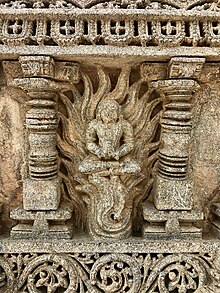Holika (Sanskrit: होलिका), sometimes also known as Simhika, was a demoness in scriptures, who was burnt to death. She was the sister of King Hiranyakashipu and the aunt of Prahlad.
The story of Holika Dahan (Holika’s death) signifies the triumph of good over evil. Holika is associated with the annual bonfire on the night before Holi, the festival of colors.
Legend

Ancient sculpture depicting Prahlada in flames.
According to folk tales Hinduism Today, a king named Hiranyakashipu who, like many demons and Asuras, had the intense desire to be immortal. To fulfill this desire, he performed the required Tapas or penances until he was granted a boon by Brahma. Since the gods rarely granted immortality, he used his guile and cunning to get a boon that he thought made him immortal. The boon gave Hiranyakashipu five special powers: he could be killed by neither a human being nor an animal, neither indoors nor outdoors, neither at day nor at night, neither by astra (projectile weapons) nor by any shastra (handheld weapons), and neither on land nor in water or air. As this wish was granted, Hiranyakashipu felt invincible, which made him arrogant. Hiranyakashipu decreed that only he be worshiped as a god, punished and killed anyone who did not accept his orders. His son Prahlad disagreed with his father, and refused to worship his father as a god. He continued believing and worshipping Lord Vishnu.
This made Hiranyakashipu very angry and he made various attempts to kill Prahlad. During a particular attempt on Prahlad’s life, King Hiranyakashipu called upon his sister Holika for help. Holika had a special cloak garment that prevented her from being harmed by fire. Hiranyakashipu asked her to sit on a bonfire with Prahlad, by tricking the boy to sit on her lap. However, as the fire roared, the garment flew from Holika and covered Prahlad. Holika burnt to death, Prahlad came out unharmed.
Vishnu appeared in the form of Narasimha – half human and half lion, at dusk (when it was neither day nor night), took Hiranyakashipu at a doorstep (which was neither indoors nor outdoors), placed him on his lap (which was neither land, water nor air), and then eviscerated and killed the king with his lion claws (which were neither a handheld weapon nor a launched weapon). In this form, the boon of five special powers granted to Hiranyakashipu were no longer useful. Prahlad and the kingdom of human beings were thus free from the compulsion and fear of Hiranyakashipu, showing the victory of good over evil.
Origin of Holika Dahan

Holika Dahan, Kathamandu, Nepal
For many traditions in Hinduism, Holi celebrates the death of Holika in order to save Prahlad. The night before Holi, pyres are burnt in North India in keeping with this tradition. In some parts of India the day is actually called Holika[citation needed]. There are other activities associated with the story of Prahlad, but the burning of Holika is the one most directly associated with Holi. The story as a whole is testament to the power of devotion (bhakta) over the evil represented by King Hiranyakashipu, as Prahlad never lost his faith. The burning of Holika is the most common explanation according to Hindu Puranas for the celebration of Holi. In different parts of India, various reasons are given for Holika’s death:
- Vishnu intervened, and hence Holika was burnt.
- Brahma had given Holika the power to resist fire on the understanding it can never be used to harm anyone, which she did.
- Holika was actually good and it was her clothes that gave her the power. Knowing the evil to befall Prahlad, she gave her garments to the boy to save him, sacrificing herself.
- When Holika sat on the pyre, she donned her flame-shielding shawl then sat Prahlad on her lap. When the fire was lit, Prahlad began praying to Vishnu, who summoned a gust of wind that blew the shawl off Holika and onto Prahlad, saving him and letting her burn to death.[4]
There is also another story behind Holi that involves a burning sacrifice for the sake of love involving Shiva and Kamadev.
Before Shiva was married to Parvati, Kamadev (God of Love) and his wife Rati (Goddess of love) tried to help Parvati win Shiva as her husband. Kamadev and Rati shot their arrow at Shiva during his meditations to make him love and marry Parvati. This disturbed Shiva, and caused his third eye to open, its powerful gaze burning Kamadev into ashes, and leaving Rati brokenhearted. Although the arrow did not work, as it was destroyed in the process, Shiva and Parvati did eventually marry. At the wedding, Rati begged Shiva to bring Kamadev back to her. Shiva agreed, and restored Kamadeva as a virtual image with true emotions.
